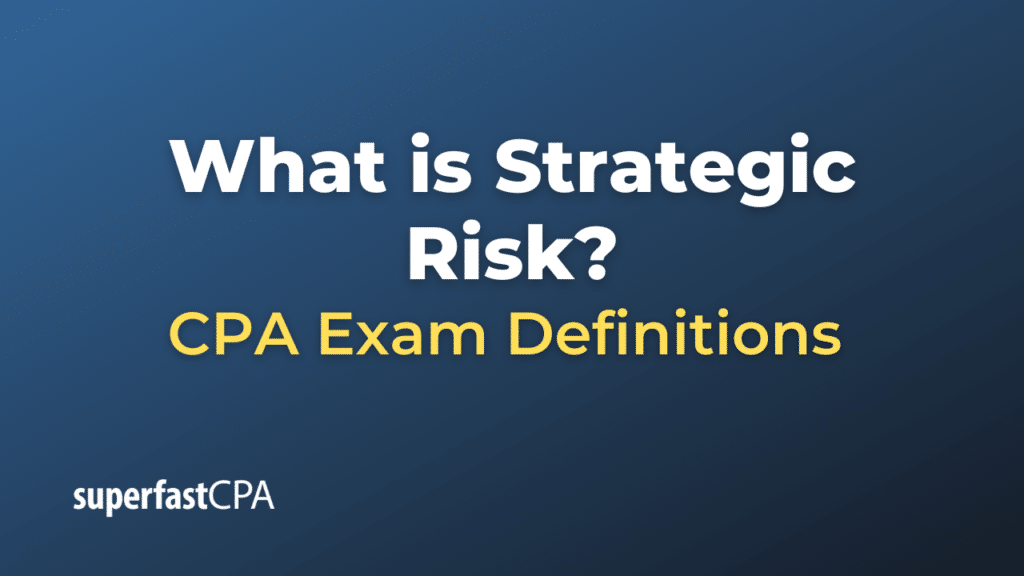Strategic Risk
Strategic risk refers to the potential risks that arise from the fundamental decisions that an organization makes about its future direction, objectives, and goals. These decisions can encompass a broad array of initiatives, such as entering new markets, launching new products, undertaking mergers or acquisitions, or adopting new business models. If these strategic decisions prove to be flawed or are poorly executed, they can potentially jeopardize the future viability of the organization.
Strategic risks can arise from various factors, including:
- Flawed Assumptions: Base decisions on incorrect or outdated market research, leading to misjudgments about market demand, competition, or other critical factors.
- External Changes: Unanticipated shifts in the market or industry, regulatory changes, technological innovations, or macroeconomic factors that render a chosen strategy ineffective or obsolete.
- Poor Execution: Even a well-conceived strategy can fail if it’s poorly implemented, due to inadequate resources, misaligned incentives, lack of internal capabilities, or other operational factors.
- Competitor Actions: Unanticipated moves by competitors, such as a new product launch or a strategic partnership, can disrupt an organization’s plans.
- Cultural Misalignment: A strategy that is inconsistent with the organization’s culture and values can face resistance from employees, leading to poor execution.
- Overdependence: Relying too heavily on a single product, market, or customer can be risky if that area faces downturns.
Example of Strategic Risk
Let’s create a hypothetical scenario involving a well-established company and the strategic risks they face when trying to diversify their product line.
Scenario: “EcoDrive Automobiles Inc.”
Background: EcoDrive Automobiles Inc. has been a leading manufacturer of gasoline-powered cars for over 50 years. Observing the global shift towards environmental sustainability and the increasing market demand for electric vehicles (EVs), EcoDrive’s leadership team decides to pivot and invest heavily in developing their own EV lineup, aiming to launch their first electric car model in three years.
Strategic Decision: To allocate a significant portion of the company’s resources (financial, R&D, marketing, etc.) to develop and promote the new EV lineup, while gradually reducing their focus on gasoline-powered cars.
Potential Strategic Risks:
- Flawed Assumptions: EcoDrive assumes that their existing customer base, who are loyal to their gasoline cars, will naturally transition to their electric models. However, these customers might be more brand-loyal than product-loyal, meaning they might switch to competitors who already have established EVs in the market.
- External Changes: Governments may implement regulatory changes faster than anticipated. For instance, if a government bans gasoline cars in urban centers in two years, EcoDrive’s reduced focus on gasoline cars might be too slow, leading to significant loss in sales.
- Competitor Actions: Competitors who started their EV journey earlier might have more advanced, efficient, and affordable models by the time EcoDrive’s first EV launches. This could make it challenging for EcoDrive to penetrate the market and gain a significant market share.
- Poor Execution: EcoDrive’s expertise lies in manufacturing gasoline cars. They might face technical challenges or delays in the EV development process due to a lack of internal expertise.
- Cultural Misalignment: EcoDrive’s internal culture and processes might be geared towards traditional automobile manufacturing. Transitioning to EV production might require a change in company culture, training, and hiring of new talent, which could face resistance internally.
- Reputational Risk: If EcoDrive’s first EV model faces issues (e.g., battery problems, limited range), it could significantly damage the company’s reputation, making future entries into the EV market even more challenging.
Outcome: Two years into their strategic decision, EcoDrive faces delays due to technical challenges in battery efficiency. Meanwhile, a competitor launches an affordable EV with impressive features. Additionally, a significant portion of EcoDrive’s loyal customer base, instead of waiting for EcoDrive’s EV, switches to this competitor. EcoDrive realizes that, in addition to the technical challenges, they failed to gauge the market dynamics and the speed at which their competitors were moving.
This example illustrates how strategic risks, if not accurately anticipated and managed, can have severe repercussions on a company’s objectives and market position.














